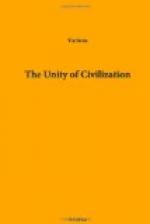What is, then, the characteristic quality or note of the Decameron and the Canterbury Tales? It is not, as some absurd persons think, to be discovered in the licentiousness or grossness of some of these tales, this only represents one aspect of their realism, and indeed in this they do little more than continue the characteristics of what we know as the ‘Fabliaux’ of the Middle Ages. The quality of the new art lies just in this, that there is nothing in human life which is uninteresting or insignificant to these great artists, that they are bound by no traditions, hampered by no conventions. They had begun as artists of romance, and the romantic sentiment of life never ceased to interest and move them, but they had learned to go beyond the romantic conventions, and to find the material of their art in everything which was part of the reality of life. To them, as to the other tale-writers of these centuries, it was quite immaterial whether they were retelling a story which had come down from immemorial antiquity, or relating something which had happened but yesterday in their own town or village, and they knew nothing of distinctions of class or rank or circumstance; it is the universal human interest which arrests them. The example which we shall find most representative is that which is to us English people the most familiar, that is the ‘Prologue’ to the Canterbury Tales. Was there ever anything greater of its kind than this? Who can ever forget these figures: the Knight, the Franklyn, the Prioress, the Wife of Bath? As we read there passes before us all the company of human life, wise and foolish, grave and gay, good and bad. Chaucer and Boccaccio are the greatest artists of what has often been called the ‘realistic’ type, they are at least very easy to distinguish from the epic and romantic artists.
They are great artists, but it is also clear enough that their powers and their insight into human life were limited. What they began was carried out to its fulfilment by the great dramatists of the sixteenth and seventeenth centuries. For this is indeed the relation of the tale-writers to the dramatists, that they furnish the materials upon which the dramatists built up their presentation of human life, or rather, the elements which are transformed by the imagination of the great dramatists from bare ‘realism’ into the highest expression of reality. No doubt the dramatists take into their work other materials and influences, but the substantial quality whether of the tragedy or the comedy is intimately related to that of the tales. How often were the great dramas built up on materials which they drew from Bandello or the other Italians who continued the tradition of Boccaccio, or from similar northern sources. But the great dramatists gave their stories a life, a passion, a breadth and fullness which is far removed from that of their sources. In their hands, or rather in their creative imagination, we see not merely the external circumstance, the bare fact, but we see all the fullness and completeness, all the exquisite grace and beauty, all the passion and terror of human experience. We may call Boccaccio and Chaucer ‘realists’, but it is only in Marlowe and Webster, and above all in Shakespeare, that we reach reality itself.




